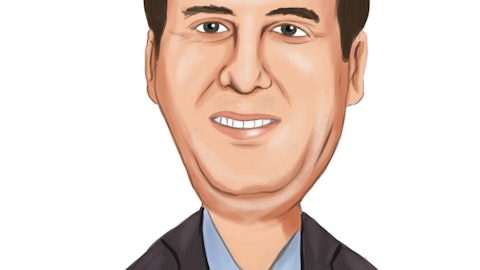Federal Agricultural Mortgage Corporation (NYSE:AGM) Q4 2023 Earnings Call Transcript February 23, 2024
Federal Agricultural Mortgage Corporation isn’t one of the 30 most popular stocks among hedge funds at the end of the third quarter (see the details here).
Operator: Good morning ladies and gentlemen and welcome to the Farmer Mac Fourth Quarter 2023 Results Conference Call. At this time all lines are in listen-only mode. Following the presentation we will conduct a question-and-answer session. [Operator Instructions]. This call is being recorded on Friday, February 23, 2024. I would now like to turn the conference over to Jalpa Nazareth. Please go ahead.
Jalpa Nazareth: Good morning and thank you for joining us for our fourth quarter and full year 2023 earnings conference call. I’m Jalpa Nazareth, Senior Director of Investor Relations and Finance Strategy here at Farmer Mac. As we begin, please note that the information provided during this call may contain forward-looking statements about the Company’s business, strategies, and prospects, which are based on management’s current expectations and assumptions. These statements are not a guarantee of future performance and are subject to the risks and uncertainties that could cause our actual results to differ materially from those projected. Please refer to Farmer Mac’s 2023 Annual Report on Form 10-K filed with the SEC today for a full discussion of the Company’s risk factors.
On today’s call, we will also be discussing certain non-GAAP financial measures. Disclosures and reconciliations of these non-GAAP measures can be found in the 2023 Form 10-K and earnings press release posted on Farmer Mac’s website, Farmer Mac.com, under the Financial Information portion of the Investors section. Joining us from management this morning is our President and Chief Executive Officer, Brad Nordholm, who will discuss 2023 business and financial highlights and strategic objectives; and Chief Financial Officer, Aparna Ramesh, who will provide greater detail on our financial performance. Select members of our management team will also join us to provide additional information on business trends and credit condition. At this time, I’ll turn the call over to President and CEO, Brad Nordholm.
Brad?
Bradford T. Nordholm: Thanks Jalpa, good morning everyone, and thank you for joining us today. 2023 was a remarkable year for Farmer Mac. We have produced double-digit earnings growth and record data factor spread and we substantially grew business volume, all while maintain credit quality and holding our efficiency ratio below our target of 30%. Our success continues to be driven by our team’s execution of our multi-year strategic plan, disciplined asset liability management decisions and funding execution, and successful business development efforts which have resulted in a diversification of our revenue streams. Our strong capital base and uninterrupted access to the capital markets support our long-term strategic growth objectives, while also providing a buffer against market volatility and changing credit market conditions.
So, let me be a bit more specific. In comparison to the prior year 2022 we concluded 2023 with a 28% growth in net effective spread to $327 million, a 38% growth in core earnings to $171 million, and a 10% growth in outstanding business volume to $28.5 billion. I believe that it is the combination of our passion for our mission, our expertise, and discipline coupled with our exceptional access to debt to securitization markets and consistent asset liability management that enables us to deliver consistently strong financial results. I fervently believe that passion for mission, the passion from our employees, our Board, our Executives, I believe that it really turbocharges our expertise and discipline to deliver these exceptional results. As you read in this morning’s press release, we announced a 27%, $0.30 per share increase in our quarterly common stock dividend to $1.40 per share beginning the first quarter of 2024.
This reflects the 13th consecutive year that Farmer Mac has increased its quarterly dividend. We are resolved to increase our dividend on an annual basis with a policy focused on achieving a targeted payout that balances a reasonable growth of both previous and future earnings, along with maintaining an adequate level of capital to exceed our requirements and support our expectations for our future business volume growth. As I’ve said for a couple of years, diversifying our loan portfolio and serving more of our clearly defined market segments has been a key priority over the last years, and that diversification is benefiting us through changing market cycles. In 2023, we provided a gross $8.3 billion in liquidity and lending capacity to lenders serving rural America, reflecting net year-over-year outstanding business volume growth of over $2.5 billion.
The rural infrastructure line of business grew $1.4 billion or 21% year-over-year to $8 billion as of year-end, primarily due to a new AgVantage facilities with existing and new counterparties and growth within the renewable energy and telecommunications portfolios. The agricultural finance line of business increased $1.2 billion or 6% year-over-year to $20.5 billion, primarily driven by the acquisition of approximately $600 million of mortgage servicing rights for Farm & Ranch loans held by and serviced for a third party. New AgVantage securities with their long-standing institutional counterparties, and loan purchase growth in Farm & Ranch companies. New AgVantage securities in the wholesale financing space were a key driver to overall volume growth in both lines of business.
The continued demand within the space reflects the comparative competitiveness of Farmer Mac’s AgVantage pricing relative to market alternatives. Looking ahead to 2024, we believe, especially given the uncertainty and volatility around the interest rate environment, that Farmer Mac will continue to be viewed as a unique relative value and diversifying funding source for many institutional counterparties. Driving exceptional growth in the rural infrastructure line of business were the renewable energy and telecommunications portfolios. As we predicted on a number of prior calls, our total renewable energy segment more than doubled in size during the year. And our telecommunications portfolio grew nearly 60% year-over-year. Given the strong demand for renewable power generation and storage, and the growing investment in fiber and broadband in rural America, we continue to focus on strategic talent acquisition in these two areas to build our expertise and capacity as market opportunities arise.
Our Farm & Ranch segment modestly increased over 2022, primarily because of the higher interest rate environment. There was relatively strong activity in the fourth quarter of 2023, and the higher demand for Farm & Ranch loan purchase product has continued into the first quarter of 2024, further reflecting borrowers’ adjustments to the new rate environment. We are cautiously optimistic about the increase in Farm & Ranch loan purchases in 2024. Farmers generally have strong cash positions, but we have seen a slower increase in land values versus the prior years, and we expect a decline in 2024 farm incomes as input costs remain elevated and commodity prices continue to recede. As we previously mentioned, we acquired $600 million of mortgage servicing rights on Farm & Ranch loans held by and serviced for a third party in the second quarter of 2023.
During 2023, we also purchased servicing rights for approximately $700 million of mortgage servicing rights for Farm & Ranch loans owned by Farmer Mac. These transactions have enabled us to expand our servicing portfolio for the first time since we added the servicing function in the third quarter of 2021. This capability gives us more direct oversight and governance of our portfolio, enhanced security, more control over timely access to data, and better visibility into loan performance from inception to maturity. Looking ahead, we will seek to continue to capitalize on this initiative to create a more efficient process for our customers and their borrowers and achieve economies of scale with minimal incremental expense. Another area of significant focus is our farm securitization program.
We have closed a $300 million transaction every year for the last three years and expect to be back in the market in the first half of 2024. We’re committed to being a regular issuer in the market with a set of securitization products that align with customer, borrower, and investor interests. Developing this capital flow to agricultural producers exemplifies Farmer Mac’s core mission to lower costs for the end-borrower and improve credit availability in rural America, while also creating an underlying agricultural investment opportunity in the capital markets. Looking ahead to 2024, we will strive to continue to be a source of reliable capital for our stakeholders as we navigate the ongoing uncertainty in the broader markets. We want to step in where we can to be a partner to our customers and more effectively fulfill our role as a secondary market provider of low cost liquidity and capital efficiency with the ultimate goal of strengthening the rural economy.
On prior calls, I’ve talked about an expansion of our approach to marketing and branding here at Farmer Mac. You will soon begin seeing our efforts to use branding to deepen our connection with our stakeholders in a compelling and uniform way to support the expansion of our mission-driven work that helps build a strong and vital rural America. The initiative is intended to highlight our distinctive position as a secondary market partner that fosters greater connections between Wall Street and Main Street America, as well as across the entire value chain to fuel growth, innovation, and prosperity in America’s rural and agricultural communities. In no small part, the fuel for that growth also comes from our active creation of more investment opportunities for the capital markets and strong access to capital.

A significant competitive advantage for us is our people and their interwoven connection of mission, expertise, and discipline. I don’t believe you can separate those attributes and how they are committed to accelerate opportunities for rural America. To recognize their contributions and even more fully align these attributes, we have continued to enhance our benefit offerings to include all employees in an equity-for-all program to make them eligible to receive annual grants of equity-based compensation. I’m extremely proud of our team and all they have accomplished in 2023. Now I’d like to turn over the call to Aparna Ramesh, our Chief Financial Officer, to discuss our financial results in more detail.
Aparna Ramesh: Thank you, Brad and good morning, everyone. 2023 was an exceptional year for Farmer Mac. Results were strong across the board, highlighting a balanced, well-measured approach, excellent credit quality, and resiliency through market cycles. Our performance in fourth quarter 2023 enabled us to finish the year with very strong momentum. Net volume growth in fourth quarter 2023 was $819 million and this was primarily driven by new AgVantage security volume in the rural utilities and Farm & Ranch segments and strong loan purchase volume across the Farm & Ranch, renewable energy, and rural utility segments. As Brad mentioned, the improvement in Farm & Ranch loan purchase volumes in the fourth quarter has created positive momentum heading into 2024.
Turning to results, core earnings were $44.9 million or $4.10 per share in fourth quarter 2023 and $171.2 million or $15.65 per share in 2023. And this reflects double-digit year-over-year growth, which was largely driven by record net effective spread of $84.6 million in fourth quarter 2023 and $327 million for the entire year. The year-over-year 16 basis point improvement in spread to 118 basis points of NES as of year-end was primarily driven by our low-cost excess capital, our debt funding strategies in previous low-rate environments, and our ability to redeploy both the excess capital and the lower cost of funds into higher earning assets. This AgVantage was further enhanced by the continued trend towards higher spread volume that is evident in our new segments like renewable energy and corporate ad finance.
The capital that we raised opportunistically when raised for its historical lows in 2020 and 2021 has reduced the need for us to raise more expensive terms and callable debt in the current rising-rate environment. We continue to defensively hold approximately $900 million in cash and other short-term instruments in our liquidity portfolio. Not only does this help us weather potential market disruptions, our excess and highly liquid capital generates immediate returns in a high nominal rate environment. While the rise in short-term rates has provided a benefit to earnings, we project limited downside to earnings if rates decline in the future, and this is due to our proactive equity capital allocation strategy where we’re laddering and layering duration to minimize balance sheet and earnings volatility.
Specifically, we expect to retain some of this benefit over the medium term even if rates decline, and to that end we’ve started extending maturities in our investment portfolio. Despite the macro headwinds, we continue to see strong access to debt capital markets and a general flight to quality investments which allows us to be very well positioned to fund new asset opportunities as they arise. Our liquidity and capital positions continue to remain well in excess of all regulatory ratios and our projections for minimal change in our profitability and limited exposure to movement in interest rates where the market projected rates go up or down. Farmer Mac maintained a monthly average of 307 days of liquidity through 2023 and had 319 days as of December 31, 2023, and these numbers reflect resiliency against short and medium-term market disruptions.
Turning to operating expenses, our operating expenses increased by 19% year-over-year due to increased headcount, increased stock compensation, and increased spending on software licenses and information technology initiatives which included consultants to support growth and strategic initiatives. We concluded 2023 with 185 employees. Expenditures associated with a multi-year technology investment, which we’ve discussed before, in our treasury and cash management systems are being executed again to enhance our trading, hedging, and reporting platforms. And this initiative has contributed significantly to the year-over-year increase in expenses. This modernization effort is expected to position us to more effectively defend against cyber and fraud threats and also allow us to scale our portfolio and diversify our product offerings that are in alignment with our business and funding strategies.
We also plan to continue to make investments in strategic-focused areas, such as renewable energy, and be the strong revenue contributors in 2023 and to continue to modernize our infrastructure, including our servicing and loan platforms to support our growth and strategic objectives. Despite the substantial increase in our expenses year-over-year, operating efficiency is held at 27% at year-end, and this is below our long-term strategic plan target of 30%. This result is a testament to our accretive revenue strategy, as well as a substantial reduction in our cost of funds driven by a disciplined approach to raising capital and managing value sheet [ph] volatility. We’ll continue to monitor our efficiency ratio and manage it such that we expect to remain at or below the long-run average of 30%.
However, as we make investments in our loan infrastructure and funding platforms and continue to innovate our loan processes using technology to accelerate growth, we may see some temporary increases that could result in the efficiency ratio rising above the 30% level. Our credit profile continues to be very strong in aggregate despite the economic headwind. 90-day delinquencies worth $35 million are 12 days at the point of our entire portfolio, and this reflects a decrease both sequentially and year-over-year. As of December 31, 2023, the total allowance for losses was $18.3 million, and this reflects a $1.1 million provision compared to year-end 2022, and this is primarily due to a single telecommunications loan that was downgraded to substandard during the year.
The provision was partially offset by a lease related to a single collateral-dependent agricultural storage and processing loan that fully paid off during the year. We ended the year with no charge-off. Let’s turn now to capital. Farmer Mac’s $1.5 billion of core capital as of December 31, 2023, exceeded our statutory requirement by $589 million, or 68%. Core capital increased from year-end 2022, primarily due to an increase in retained earnings, which reflects a substantial improvement in both the quantity and the quality of our capital base, and this is reflected in our Tier 1 capital ratio, which improved to 15.4%. Our consistent earnings strongly support the $0.30 per share increase in our quarterly common stock dividend, and we are very pleased that we can offer this return to our shareholders while maintaining strong capital ratios to defend our balance sheet and also fueling our growth objectives.
We will continue to invest significant resources to enhance our infrastructure and engage with our customers and investors to support a robust and liquid market for our farm securitization product. Securitization has many beneficial aspects for Farmer Mac. It allows us to diversify our funding, enhance and optimize our balance sheet through the efficient deployment of capital, and it can enable our growth strategy by targeting new asset opportunities into our conduit. While we are closely monitoring a changing market dynamic, we fully expect to return to the market in the first half of 2024 with another similar farm securitization transaction as the previous three transactions. As we assess our strategic objectives for the program, we plan to transform what has been a financing strategy to start to offer this as a vehicle for capital efficiency and growth for our counterparties.
So in summary, our entire team delivered exceptionally good quarterly results while fulfilling several important strategic and revenue objectives. We delivered on our key metrics that we report to you on each call. We had record core earnings and continued strong credit performance, and all of this resulted in a 19% return on equity while holding the efficiency ratio below our 30% target. As the interest rate environment moderates, we remain optimistic that the natural hedges within our business and balance sheet should allow for a more sustainable long-run average in that effective spread. Looking ahead to 2024, we remain well positioned and more optimistic than ever to deliver on our long-term strategic plan objectives. And with that, Brad let me turn it back to you.
Bradford T. Nordholm: Thank you, Aparna. We are extremely proud of our financial results for 2023. As Aparna was saying, we believe that we’re well positioned heading into 2024 with strong liquidity and capital levels, a diversified business mix, highly effective risk management practices, and an expanded team of dedicated professionals. We’re very optimistic about the future, and we’ll maintain our singular focus on fulfilling our mission efficiently and innovatively as we navigate the backdrop of broader market uncertainty attributable to interest rates, regulation, and policy change. This is how we believe we can continue to differentiate ourselves and deliver value to our customers and end-borrowers in rural America. And now, operator, I’d like to see if we have any questions from anyone on the line with us today.
Operator: Thank you. [Operator Instructions]. Your first question comes from Bill Ryan with Seaport Research. Please go ahead.
See also 10 Fastest Growing Energy Drink Stocks in the US and 20 Best Cities to Retire on $10,000 a Month Anywhere in the World.
Q&A Session
Follow Federal Agricultural Mortgage Corp (NYSE:AGM)
Follow Federal Agricultural Mortgage Corp (NYSE:AGM)
William Ryan: Good morning, and congratulations on your 2023 results. Question on the margin specifically, the net effect of spread on renewable energy and utilities both improved quarter-over-quarter. Renewable energy quite a bit. I believe, Brad, last quarter you talked about maybe some pricing strategies that were being implemented to maybe enhance sort of the yields. Could you talk about what the drivers of the margin in the quarter was or the NES in those two business lines?
Bradford T. Nordholm: Okay, Bill, good morning, and yeah, thanks very much. We also have Zach Carpenter on, so I’m going to ask Zach to provide you with a little additional color. But I believe on prior calls I talked about how over the last few years we have really tried to move our pricing from being pricing that really achieved the lowest acceptable threshold from Farmer Mac to pricing that reflect more of the market. And that’s resulted in more variation between business segments and also within deals within the business segments. So that’s part of it. We also are becoming better established in the markets and have a growing reputation among market players, which allows them to see us as a premium player, and that puts us in a position of a bit better negotiating position as well. But let me turn to Zach to really kind of flush this out for you in more detail.
Zachary N. Carpenter: Yeah, happy to, Brad and thanks, Bill. Brad touched on most of the key attributes. I’d highlight three main things. Focused on rural utilities, just remember the telecommunications portfolio is included in that segment. That sector by itself has much higher net effective spread just given the risk profile of those transactions. And again, in that space, we’re really focused on pricing to market and making sure that the transactions that we’re bringing on board reflect the risk that we have in those. I think the second is more of a market construct in terms of the volatility we’ve seen. What that created in 2023 was kind of a widening of credit spreads across, I think, most sectors of Farmer Mac. And so as we execute in all three of the spaces, portfolios, telco, rural utilities, and renewable energy, we saw a widening of credit spreads in 2023, which also resulted in an increase in that effective spread.
And the last thing I would note is just specifically focused to renewable energy, our primary target and focus is really in that middle market type transactions and not necessarily the largest transactions in the market. And that by itself has focused us more on, I think, more accretive net effective spreads than some of the other transactions. So I think the combination of those three things is really what caused an accretive net effective spread in the rural infrastructure space.
William Ryan: Okay, and one follow-up also related to the net effective spread. But in terms of portfolio repricing, we’ve obviously been in a fairly stable interest rate environment. I think last quarter everybody was expecting a more dramatic reduction in market interest rates. And we talked about the overall margin maybe being a little bit under pressure. But kind of where we’re at right now, it doesn’t look like rates are going to go down nearly as much and the portfolio continues to reprice. Are we kind of looking more, let’s just say, everything held constant at the stable type NES, not adjusted for mix or anything or with ongoing repricing of the existing portfolios show some potential upside to the core margin?
Bradford T. Nordholm: Well, from an asset liability management, those asset liabilities are quite well matched. And so unlike banks, when we have a movement in rates, for example, increase in deposit costs, it doesn’t put pressure on us. But in terms of the repricing of the existing portfolio, that really goes to a prepayment question. Zach, why don’t you provide some insight into what’s happening with our prepayments as well as the new origination opportunity.
Zachary N. Carpenter: Yeah, absolutely. Specifically, in the Farm & Ranch segment, rates still remain high comparatively to the last 10 to 15 years. So our prepayments have remained historically low and we continue to expect that to take place at least for the foreseeable future into 2024. That does — the new volume that we bring on is not making up for lost refinancing volume. And that would tend us to think that spreads will be relatively stable in the Farm & Ranch line of business. The only other thing I would highlight and this directly goes on the asset side of the book as it pertains to net effective spread is we have seen a pretty significant tightening of credit spreads across the spectrum heading into 2024. And so as we look at kind of our other products and segments, we’ll take that into consideration as we look to deploy more capital.
But, again the volatility in the market kind of moved the other way starting in 2024. And so that could impact certain refinancing activity in some of the other segments. But in our core Farm & Ranch and corporate ag segment, I think we’re pretty confident that it’s going to be relatively stable at least for the foreseeable future.
William Ryan: Okay, thanks for taking my questions.
Operator: Your next question comes from Bose George with KBW. Please go ahead.
Bose George: Hey, everyone. Good morning. Just wanted to follow up on the spread question. If the Fed does cut rates in the back half of the year, is the impact mainly on the treasury function just with your cash there and in terms of the hedges that you discussed, is it really kind of to offset the impact on that part of the liability structure?
Bradford T. Nordholm: Yeah, I think we’ve commented, Bose, on the -– and good morning. I think we’ve commented on the relative stability of spreads around our loan portfolio. So Aparna, why don’t you -– since we do carry a very large investment in liquidity portfolios, why don’t you provide some insight into how rates would impact that.




